Mini reviews
Tarmo Kunnas: Fasismin lumous. Eurooppalainen älymystö Mussolinin ja Hitlerin politiikan tukijana [The allure of fascism. European intellectuals as backers of the policies of Mussolini and Hitler]
13 March 2014 | Mini reviews, Reviews
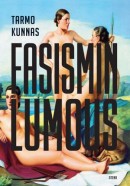 Fasismin lumous. Eurooppalainen älymystö Mussolinin ja Hitlerin politiikan tukijana
Fasismin lumous. Eurooppalainen älymystö Mussolinin ja Hitlerin politiikan tukijana
[The allure of fascism. European intellectuals as backers of the policies of Mussolini and Hitler]
Jyväskylä: Atena , 2013. 686 pp .
ISBN 978-951-796-933-8
€40, hardback
The most prominent fascist states in the period between the world wars were Nazi Germany and Mussolini’s Italy, but the ideology was reflected in the extremist movements of a number of European countries. The fascist movements could differ greatly, but their key feature was a strong nationalism that was both anti-democratic and anti-parliamentary. In his book, which at times is rather heavy going, Emeritus Professor Tarmo Kunnas examines the attraction of Fascist ideology for the European intelligentsia of the 1920s, 30s and 40s. He presents a nuanced view of the opinions of the period’s major intellectuals and detects the sources of their world outlook in factors like their philosophy of life. Their fascism rarely fitted in with party political programmes. Kunnas also sheds light on the fascist views of some of Finland’s cultural figures; according to him, in Finland genuine fascist groups did not really have much significance.
Translated by David McDuff
Eerikinkronikka [Eric’s Chronicle]
6 March 2014 | Mini reviews, Reviews
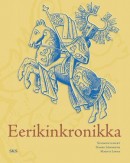 Eerikinkronikka
Eerikinkronikka
[Eric’s Chronicle]
Finnish translation by Harry Lönnroth, Martti Linna
Helsinki: Suomalaisen Kirjallisuuden Seura [Finnish Literature Society], 2013. 221pp.
ISBN 978-952-222-445-3
€35, hardback
Eerikinkronikka (Erikskrönikan) is both an important source of knowledge about Finland’s medieval history and a chivalric epic poem. The Old Swedish text was possibly written during the 1320s by Duke Eric’s secretary, the priest Torkel Kristinsson. Philologist Harry Lönnroth and historian Martti Linna have translated the work into Finnish for the first time, in prose form, with an extensive introduction by Lönnroth. The epic depicts the political history of Sweden in the 13th and 14th centuries, and also the struggle for power within the family of the well-known statesman Birger Jarl (died 1266). One of the central characters is the idealised Duke Eric (died c.1318), whose son becomes King Magnus Eriksson. The narrator comments on events in a laconic style that often has a religious tinge. The epic gives a vivid and dramatic account of chivalric life and life in the kingdom of Sweden, of which Finland was a part. At the time the Swedes were consolidating their power in Finland; the work mentions Birger’s ‘crusade ‘ to Häme in southern Finland, the founding of Häme Castle, and battles in Karelia.
Translated by David McDuff
Avartuva maailma. Kartta-aarteita A. E. Nordenskiöldin kokoelmasta [The expanding world. Treasures of the A.E. Nordenskiöld Map Collection]
27 February 2014 | Mini reviews, Reviews
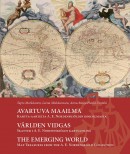 Avartuva maailma. Kartta-aarteita A. E. Nordenskiöldin kokoelmasta
Avartuva maailma. Kartta-aarteita A. E. Nordenskiöldin kokoelmasta
[The expanding world. Treasures of the A.E. Nordenskiöld Map Collection]
Tapio Markkanen, Leena Miekkavaara , Anna-Maija Pietilä-Ventelä
Helsinki: Finnish Literature Society, 2013. 175 pp., ill .
ISBN 978-952-222-431-6
€47, paperback
In the late 19th century the Finnish-born scientist and explorer Adolf Erik Nordenskiöld (1832–1901) assembled an extensive collection of historical maps which gained international recognition. The collection is housed in the Finnish National Library and in 1997 was included in UNESCO’s Memory of the World register. In 2013 an exhibition featuring part of the collection was held in Helsinki. Avartuva maailma is a beautifully illustrated book, with large pages containing plenty of text (in Swedish and English). Professor Tapio Markkanen examines the changing picture of the world from antiquity to modern times, as well as the development of maps and cartography. In some ancient maps the continents were portrayed in the likeness of people or animals, or with the south being placed at the top. An essay by map historian Leena Miekkavaara traces Nordenskiöld’s biography, showing how he acquired world fame after making the first complete crossing of the Northeast Passage in 1878. The Collection is presented and introduced by the researcher Anna-Maija Pietilä-Ventelä, with illustrations that also cover the history of cartography.
Translated by David McDuff
Markku Jokisipilä & Janne Könönen: Kolmannen valtakunnan vieraat. Suomi Hitlerin Saksan vaikutuspiirissä 1933–1944 [Guests from the Third Reich. Finland in the sphere of influence of Hitler’s Germany 1933–1944]
20 February 2014 | Mini reviews, Reviews
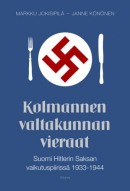 Kolmannen valtakunnan vieraat. Suomi Hitlerin Saksan vaikutuspiirissä 1933–1944
Kolmannen valtakunnan vieraat. Suomi Hitlerin Saksan vaikutuspiirissä 1933–1944
[Guests from the Third Reich. Finland in the sphere of influence of Hitler’s Germany 1933–1944]
Helsinki: Otava, 2013. 602 pp., ill .
ISBN 978-951-1-26881-9
€37, hardback
Germany had long been a great power with close historical ties to Finland, and when Hitler took over in 1933 the bond was still largely intact. Some Finnish cultural and scientific figures admired the new Germany and accepted its ideology, whereas the views of many Finland’s soldiers were influenced by the help received from Germany during the Civil War of 1918 and by the threat from the neighbouring Soviet Union. During the Winter War of 1939–40, when the Soviet Union attacked Finland and Germany was formally a Soviet ally, relations cooled. After the Winter War politicians sought support from Germany for reasons of Realpolitik, in preparation for another conflict. When the Germans invaded the Soviet Union during the Continuation War of 1941–1944, they sent military supplies to Finland and troops to the country’s north. Cultural relations with the Baltic superpower flourished. Hitler’s attendance in 1942 at the birthday party of Marshal Mannerheim (well known to be an Anglophile) was a spectacular display of Finnish-German friendship. However, no persecution of Jews took place in Finland. When it became obvious that Germany would be defeated, even the Nazis’ enthusiastic friends distanced themselves from them, and in the Lapland War of 1944–45 the German soldiers were driven out of Finland. The book provides a vivid and comprehensive reminder of a time when many Finns put their trust in Hitler’s Germany and were flattered to receive its attention.
Translated by David McDuff
Tuomo Pietiläinen & Tutkiva työryhmä [Research working group]: Wahlroos: epävirallinen elämäkerta [Wahlroos: an unofficial biography]
13 February 2014 | Mini reviews, Reviews
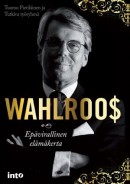 Wahlroos: epävirallinen elämäkerta
Wahlroos: epävirallinen elämäkerta
[Wahlroos: an unofficial biography]
Helsinki: Into Kustannus Oy, 2013. 432 pp. , ill.
ISBN 978-952-264-243-1
€35, hardback
Björn Wahlroos (born 1952) is a business and banking executive who is now chairman of Nordea, the Nordic region’s largest bank. The journalist Tuomo Pietiläinen, working in collaboration with 25 students, has produced a biography of Wahlroos as part of a course in investigative journalism, without the involvement of the subject himself. Wahlroos is a firm believer in the hard market economy. Based on careful background research, this biography charts Wahlroos’s progress from boy scout to radical left-wing student, his conversion to capitalism and his rapid rise to become a popular professor of economics. In the 1980s Wahlroos moved to the banking sector and climbed to the top of Finland’s business elite. Outspoken, both admired and hated, he is also the owner of an estate with cultural and historical significance, where he works as a part-time farmer. His hunting partners include the King of Sweden. This account of Wahlroos’s colourful career is written clearly and informatively enough to be understood even by those who don’t know anything about business.
Translated by David McDuff
Kirjailijoiden Kalevala [The writer’s Kalevala]
7 February 2014 | Mini reviews, Reviews
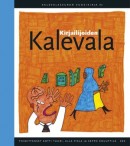 Kirjailijoiden Kalevala
Kirjailijoiden Kalevala
[The writer’s Kalevala]
Toim. [Ed. by]: Antti Tuuri, Ulla Piela ja Seppo Knuuttila
(Kalevalaseuran vuosikirja 92, the Kalevala Society’s yearbook 92)
Helsinki: Suomalaisen Kirjallisuuden Seura, 2013. 313 pp., ill.
ISBN 978-952-222-429-3
€47, hardback
The Kalevala is the Finnish national epic, compiled from oral folk poetry by Elias Lönnrot. It has provided a source of inspiration to Finnish culture since 1839. Kirjailijoiden Kalevala continues a project entitled ‘The artists’ Kalevala’, started in 2009. To start with, four scholars examine, from different viewpoints, the influence of folk poetry and the Kalevala on literature. Some twenty Finnish-language authors then approach the epic with original thoughts and literary means. The result may take the form of reminiscing, of a short story, poem or cartoon. In some texts the Kalevala is present only indirectly, in others some character of the epic is placed in the focus – Väinämöinen, Kullervo, Lemminkäinen or Aino. Kirjailijoiden Kalevala offers a multifaceted collection of viewpoints; aptly, the editors, in their foreword refer to the epic as a literary sampo, the mysterious, mythical object of the Kalevala that generates wealth and riches.
Kuka on saamelainen ja mitä on saamelaisuus – identiteetin juurilla [Who is a Sámi and what being Sámi means – looking for the roots of identity]
30 January 2014 | Mini reviews, Reviews
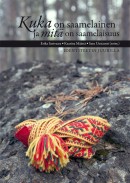 Kuka on saamelainen ja mitä on saamelaisuus – identiteetin juurilla
Kuka on saamelainen ja mitä on saamelaisuus – identiteetin juurilla
[Who is a Sámi and what being Sámi means – looking for the roots of identity]
Toim. [Ed. by]: Erika Sarivaara, Kaarina Määttä & Satu Uusiautti
Rovaniemi: Lapin yliopistokustannus (Lapland University Press), 2013. 182 pp.
ISBN 978-952-484-651-6
€29, paperback
This anthology updates one of the most burning questions, one which also has political consequences: who has the right to belong to an indigenous people, and who is entitled to define it? Of the approximately 100,000 Sámi – the only indigenous people in the European Union – around 7,000 live within Finnish territory. The writers represent Sámi research at the Lapland University, and they examine the definition of ‘the Sámi without a status’, i.e. people not included on the election list for the Sámi Parliament. The book questions the prevailing discourse, which characterises Sámi history as a withdrawal from the progress of civilisation; this is interpreted as a survival strategy, and the Sámi are not primarily regarded as the victims of colonialism and modernisation. The work also highlights the inner hierarchies of the Sámi and analyses both the reindeer-farming Sámi, regarded as elite, as well as the marginalia, the Sámi who engage in forestry and agriculture to make a living. Articles are sensitive, sometimes provocative, and they shine a spotlight on every ethnic group as well as the fundamental questions of the individual, the right to one’s own identity, language and history.
Hannu Raittila: Terminaali [Terminal]
23 January 2014 | Mini reviews, Reviews
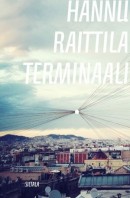 Terminaali
Terminaali
[Terminal]
Helsinki: Siltala, 2013, 454 pp.
ISBN978-952-234-174-7
€32.90, hardback
The airport is a fertile environment for a contemporary novel: a crucible of chance encounters. In his sixth, extensive novel, Hannu Raittila (born 1956) masterfully combines plot and structure: there is adventure, personal relationships, hard living, a love affair, life on a remote Swedish-speaking island. Commodore Lampen sets out to look for his daughter Paula, who has been forcibly brought back to Finland after spending years touring foreign airports. Back in the 1990s Paula and her friend Sara spent a lot of time at Helsinki airport, which developed its own culture of international encounters; this then took them abroad – by accident, on 11 September 2001. Various adventures ensued, including an involvement with the Syrian civil war. Globalisation is based on the free mobility of goods and people, but it also means crumbling of societal structures, and in Raittila’s novel – paradoxically enough – the growing rarity of human encounter.
Mikko-Olavi Seppälä & Riitta Seppälä: Aale Tynni. Hymyily, kyynel, laulu [Aale Tynni. A smile, a tear, a song]
16 January 2014 | Mini reviews, Reviews
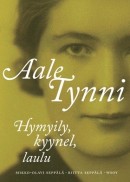 Aale Tynni. Hymyily, kyynel, laulu
Aale Tynni. Hymyily, kyynel, laulu
[Aale Tynni. A smile, a tear, a song]
Helsinki: WSOY, 2013. 488 pp., ill.
ISBN 978-951-0-38306-3
€37, hardback
The poet, author and translator Aale Tynni (1913–1997), an Ingrian Finn who came to Finland as a refugee after the First World War in 1919, published 15 collections of poetry between 1938 and 1987. Among her translations are works by Ibsen, Shakespeare, Yeats and Racine. This extensive biography, compiled and written by Tynni’s daughter Riitta Seppälä and her grandson, historian Mikko-Olavi Seppälä, is an in-depth, lively portrait of a poet who, in her time, was both admired and criticised for her choices of form and content. Tynni felt that classical metrical tradition was closest to her, and patriotism was one of her themes; however, in the postwar years the freedom of rhythm of Finnish modernism began to flourish, and politics also gained strength in the literary world. In 1948 Tynni won the gold medal for literature in the – rather bizarre and short-lived – art competitions at the Summer Olympics in London with her poem ‘Laurel of Hellas’. Tynni experienced dramatic turns in her personal life; she underwent a prolonged divorce from her first husband who bitterly fought it. Two of her three children committed suicide in adulthood. She was finally free to marry the widowed poet Martti Haavio (aka P. Mustapää) in 1960, a marriage of soulmates that lasted until Haavio’s death in 1973.
Malin Kivelä & Linda Bondestam: Bröderna Pixon och TV:ns hemtrevliga sken [The Pixon brothers and the homely shimmer of the telly]
9 January 2014 | Mini reviews, Reviews
 Bröderna Pixon och TV:ns hemtrevliga sken
Bröderna Pixon och TV:ns hemtrevliga sken
[The Pixon brothers and the homely shimmer of the telly]
Helsingfors: Schildts & Söderströms, 2013. 38 pp.
Illustrerad av [Illustrated by] Linda Bondestam
ISBN 978-951-523-124-6
€22, hardback
Finnish translation:
Pixonin pojat ja TV:n kotoisa kajo
Suomentanut [translated by] Maarit Halmesarka
Helsinki: Teos, 2013. 38 pp.
ISBN 978-951-851-524-4
€27.90, hardback
The four Pixon brothers spend their time watching the telly and eating cereals and sweets. Their mother, in desperation, constantly demands that they go out and play, but they just don’t. The thin brothers’ teeth are bad as they have no vitamins in their blood: indeed they are as fit as 90-year-olds. One day the telly goes bust and the brothers end up in their neighbours’ home, where the two ladies cook them a good meal. They finally do go out and play – until the point of exhaustion: the story presents the reader with sinister turns à la Grimm brothers or Hoffmann, which the gloomy, dark pictures, suddenly devoid of colours, comically illustrate. But colours return to the pictures as well as to the brothers, who are now as fit as any 64-year old! This is the authors’ second book for children. Kivelä’s lesson takes the mickey out of didacticism but does not lose the point, so fun is had by all. Bondestam’s detailed, graphic pictures spice the story with amusing horror.
Kreetta Onkeli: Poika joka menetti muistinsa [The boy who lost his memory]
9 January 2014 | Mini reviews, Reviews
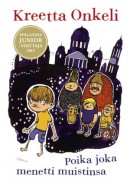 Poika joka menetti muistinsa
Poika joka menetti muistinsa
[The boy who lost his memory]
Helsinki: Otava, 2013. 111 pp.
ISBN 978-951-1-27022-5
€22.90, hardback
Kreetta Onkeli, better known for her books for adults, was awarded the 2013 Finlandia Junior award for this book. Arto is a schoolboy who loses his memory, but goes off in search of himself with an open mind. He meets a number of people who are outsiders in various ways and learns important lessons from each of them. Onkeli portrays a child of around 11 to 13 who is confused by many things. Researchers consider this age group to fall into an in-between area: there aren’t enough appealing activities on offer for kids of this age, who are treated as an awkward bunch both at home and at school. This book contains some rule-breakers: the boys eat at a restaurant buffet without paying and ride the subway without a ticket while other characters hint at forging official documents. Adult readers with their eyes closed to reality might consider Arto’s odyssey an anxiety-inducing vision of the future, in which grown-ups are not shown in a flattering light. Children, however, will get wrapped up in this absurd adventure.
Translated by Ruth Urbom
Alexandra Salmela: Kirahviäiti ja muita hölmöjä aikuisia [The giraffe mummy and other silly adults]
9 January 2014 | Mini reviews, Reviews
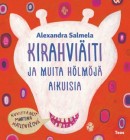 Kirahviäiti ja muita hölmöjä aikuisia
Kirahviäiti ja muita hölmöjä aikuisia
[The giraffe mummy and other silly adults]
Kuvitus [Ill. by]: Martina Matlovicová
Helsinki: Teos, 2013. 96 pp., ill.
ISBN 978-951-851-466-7
€27.90, hardback
The first children’s book by Alexandra Salmela, who has previously published a novel for adults, brings some sorely needed anarchy to Finnish storybooks. The 21 brief stories encourage children to add to them, whether by drawing, writing or out loud. Salmela’s tales are populated by trolls, dragons, knights and princesses, as well as ordinary children with silly parents. A boy called Ossi has two mums: Little Mum and Big Mum. One night, Little Mum collapses under the Tree of Exhaustion, but Ossi and his little sister hug their mum better. Allu’s absent-minded dad manages to mislay his head, and two perfect parents trade in their defective son Sulo at the child repair shop. The collage images by Slovakian illustrator Martina Matlovičová will work their way straight into your subconscious and start to bubble away.
Translated by Ruth Urbom
Jukka Laajarinne & Timo Mänttäri: Isä vaihtaa vapaalle [Dad takes time off]
9 January 2014 | Mini reviews, Reviews
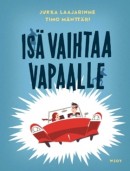 Isä vaihtaa vapaalle
Isä vaihtaa vapaalle
[Dad takes time off]
Kuvitus [Ill. by]: Timo Mänttäri
Helsinki: WSOY, 2013. 31 pp., ill.
ISBN 978-951-0-39780-0
€26.90, hardback
Isä vaihtaa vapaalle is a picture book infused with wry humour which lends itself to both realistic and fanciful readings. In the story, a girl’s father is a secret agent. He’d like to reduce his working hours to spend more time with his daughter, but his employer has other ideas. This book provides an amusing reflection of its time: parents’ job titles often do not mean much to children, so their strange roles and the heavy briefcases parents lug home start to take on a life of their own in children’s minds. The story is free from clichés about gender roles and will entertain boys and girls alike. Timo Mänttäri, making his debut as a children’s book illustrator here, depicts fast-paced, dangerous situations and amusing details. The comic book-style narrative and large, double-page illustrations create suspense in this zippy story. The words and pictures are seamlessly integrated, and the not-overlong text is balanced by the exceptionally strong, expressive visuals.
Translated by Ruth Urbom
Riitta Jalonen & Kristiina Louhi: Aatos ja Sofian meri [Aatos and Sofia’s sea]
9 January 2014 | Mini reviews, Reviews
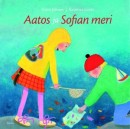 Aatos ja Sofian meri
Aatos ja Sofian meri
[Aatos and Sofia’s sea]
Kuvitus [Ill. by]: Kristiina Louhi
Helsinki: Tammi, 2013. 36 pp., ill.
ISBN 978-951-31-7048-6
€21.90, hardback
The duo of Riitta Jalonen and Kristiina Louhi has come up with yet another well-rounded picture book trilogy. Aatos and Sofia are sensitive, independent preschoolers, each with a good imagination and the ability to savour fleeting moments. It is rare for children’s books to contain such a nuanced yet natural portrayal of companionship and devoted friendship between children. Sofia has her feet more firmly planted on the ground that Aatos, who is more prone to let his emotions run free. Sofia’s mum’s aerobics sessions are a fun contrast with the children’s slower-paced lifestyle, in which they hold on to individual moments. This book champions children’s free, creative play and their right to a long childhood. Kristiina Louhi’s illustration style is both traditional and extremely modern.
Translated by Ruth Urbom
Juba: Minerva. Alajuoksun kelluva pullukka [Minerva. The floating dumpling of the Lower Reaches]
9 January 2014 | Mini reviews, Reviews
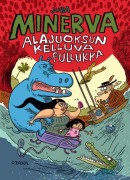 Minerva. Alajuoksun kelluva pullukka
Minerva. Alajuoksun kelluva pullukka
[The floating dumpling of the Lower Reaches]
Helsinki: Otava, 2013. 48 pp., ill.
ISBN 978-951-1-25731-8
€17.80, hardback
Minerva is a cartoon character who has appeared in two previous volumes (2006, 2009) by Juba, a.k.a. Jussi Tuomola. Juba is the creator of an extremely popular comics series for adults about the woman and the pig (both male chauvinist and porcine), Viivi and Wagner. Minerva is a brave and extremely resourceful little heroine who is never daunted by even the wildest adventures she experiences after leaving home to fly around in weird lands. Petra, the floating dumpling of the Lower Reaches, is a woman with magical powers who likes to travel in a flying gondola. In this volume Minerva also meets other old friends on her journey under water, underground, on a river and in the air above a jungle, in pursuit of a rare ingredient for a perfume that Petra has determined to acquire no matter what. The comedy in the uninhibitedly fantastic adventures, illustrated effectively in cartoon squares of different sizes, will amuse readers of many ages.
